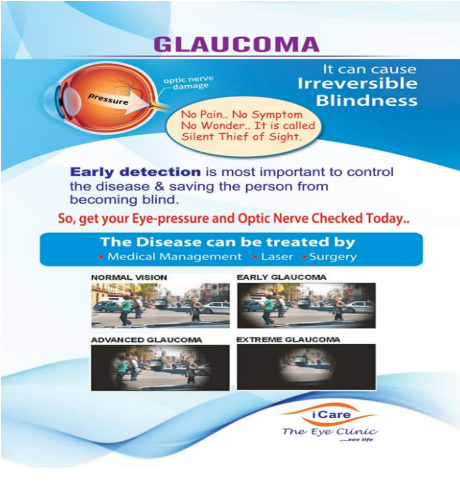Glaucoma

Inside the front of the normal eye, there is a constant inflow and outflow of a clear, nourishing fluid. This fluid drains back into your body’s circulation and is called aqueous humor.
The aqueous flow system maintains a relatively constant eye pressure much like a balloon. Aqueous flows from the ciliary body behind the iris, through the pupil, and out the trabecular meshwork.
Types of Glaucoma
Open Angle Glaucoma
Open angle glaucoma is the most common type. The trabecular meshwork may become blocked. Continued inflow of the fluid increases the intraocular pressure. This can damage the optic nerve leading to loss of vision.
Closed Angle Glaucoma
With closed angle glaucoma, fluid outflow may be blocked at the pupil. This can cause a more sudden increase in eye pressure. The iris may move forward to further block the drain area.
In cases of acute angle closure glaucoma, aqueous flow first becomes blocked at the pupil's edge. Increased pressure behind the iris forces the iris forward. The iris then blocks the angle outflow area. This can cause a sudden increase in intraocular pressure requiring immediate attention.
Greater-than-normal eye pressure can damage the eye’s optic nerve, resulting in a loss of vision over time. Damage to the optic nerve usually causes loss of side vision first, followed by critical central vision. Untreated, glaucoma can cause total blindness.
Detection of Glaucoma
Glaucoma is detected in several ways. Your eye care provider may use several tests. In one such test, only a puff of air touches the eye. The air indents the cornea and the size of a reflected light ring is measured.
Several additional tests may be performed to confirm accuracy of the intraocular pressure readings.
Examination of the eye may include the use of a slit lamp. A narrow beam of light highlights the condition of the important angle drainage area. To examine the aqueous drainage area in greater detail, gonioscopy may be performed. Your eye care provider uses a special hand-held contact lens that has a mirror.
The optic nerve in the back of the eye may be examined under high magnification using indirect ophthalmoscopy. This is performed to monitor any damage or change to the nerve's condition.
Field of vision is tested for any loss or change to vision. Several other types of tests and examinations may be performed. Photographs may be taken to compare and note any changes to your eyes in the future.
Treatment of Glaucoma
Glaucoma treatments aim to reduce the eye’s pressure by either decreasing aqueous inflow or by increasing outflow. In most cases, daily eye drop medication can control glaucoma. To be effective, they must be used consistently and as directed.
In cases of pupillary block glaucoma, a laser iridotomy may be performed. The laser creates a small hole in the peripheral outer iris. This iridotomy hole provides a new pathway for aqueous to flow to the angle drainage area. This aims to reduce the eye pressure.
The trabeculum may be treated directly with laser when medications fail to control glaucoma. Laser applications look to open the aqueous outflow area. Argon laser trabeculoplasty opens outflow areas by shrinking the adjacent tissue. Alternatively, the cold laser of selective laser therapy changes the trabecular tissue with less scarring. In both types, the subsequent increased outflow drops the eyes pressure.
Surgery is used in difficult cases of glaucoma. First, a flap is created in the white sclera of the eye. A section of the outflow area is removed. The scleral flap is placed back over the area. Now, a controlled aqueous outflow can occur as a small filtering bleb. A derivative technique places a small collagen implant under the flap to assist outflow.
Summary
Glaucoma may lead to blindness if not diagnosed and treated early. Glaucoma can steal your vision without you noticing, so regular check-ups are important in detecting early signs. Some higher risk groups include people over 35 years of age, diabetics, of African descent, those with high degrees of nearsightedness, and those with a family history of glaucoma. To be effective in preventing the progressive damage glaucoma can cause to your vision, medications must be used consistently and as directed. Any changes to your vision should be brought to your eye care provider’s attention immediately.
Contact Us
If you have any other questions or concerns, please contact us at:
The Eye clinic
Dr Swati Agarwal -The Eye Clinic
2A Motilal Basak lane
Kakurgachi
Kolkata, WB 700054
www.swatiagarwal.in
+91 9147714355
[email protected]
Important Note
This information is provided for general educational concepts only. Your specific circumstances, conditions, treatment approaches, and results may vary from those shown here. Additional information, instructions, and precautions are to be provided by and discussed with your eye care provider.
Need Urgent Help?
Call Us: